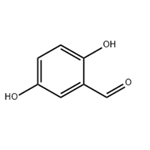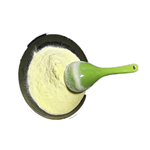Description
2,5-Dihydroxybenzaldehyde is a building block. It has been used in the synthesis of 2,4-dimethylbenzoylhydrazones with antileishmanial and antioxidant activity.
Chemical Properties
yellow to khaki-green crystalline powder
Application
2,5-Dihydroxybenzaldehyde is a is a natural phenol found in the heartwoods of Pseudolarix amabilis, it is a tyrosine kinase inhibitor. 2,5-Dihydroxybenzaldehyde has antimicrobial activity and is mostly used in experimental studies for the preparation of Schiff base derivatives and bioanodes for glucose fuel cells.
Uses
2,5-Dihydroxybenzaldehyde (cas# 1194-98-5) is a compound useful in organic synthesis.
Definition
ChEBI: 2,5-dihydroxybenzaldehyde is a dihydroxybenzaldehyde carrying hydroxy groups at positions 2 and 5. It has a role as a Penicillium metabolite, a mouse metabolite and a human metabolite.
Preparation
Add 80 mmol of dry paraformaldehyde to a mixture of 12 mmol of the phenol derivative and 2.5 mmol of MgO nanocrystalline (0.1 g). Expose the resulting mixture under microwave irradiation with a power of 650 W. Monitor the progress of the reaction by thin layer chromatography (TLC) developed by n-hexane : ethyl acetate (8 : 2). Add 100 mL of sulfuric acid (15% w/w) to the reaction mixture and heated at 50 °C for 15 min. Cool the reaction mixture to room temperature. Extract the product by dichloromethane (2 x 50 mL). Dry the organic layer over anhydrous magnesium sulphate. Evaporate the solution resulting from filtration to obtain the crude product. Purify the other product by column chromatography using n-hexane : ethyl acetate (95 : 5 to 70 : 30).







